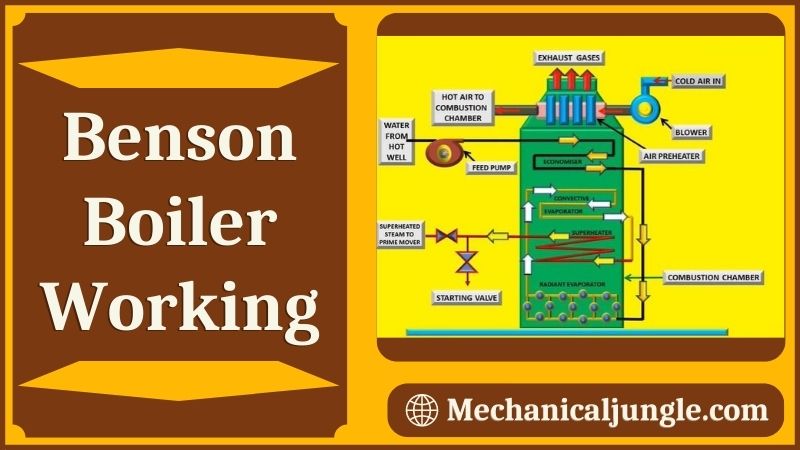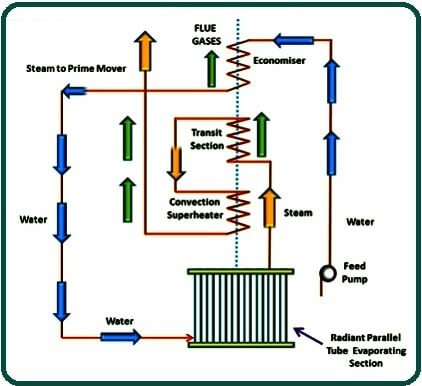
What is Benson Boiler?

It is a high-pressure water tube boiler with the forced circulation that operates on the basic principle of critical pressure of water. The stress boiler was invented in 1922 by Mark Benson.
This boiler is a supercritical boiler. In this boiler, no bubbles are formed on the surface of the water as the water is compressed under supercritical pressure.
When water enters the boiler, it suddenly converts to steam as it enters the boiler just above the critical pressure. No air separator drums are required to separate air bubbles from waters. The critical pressures are the pressure at which the liquid & gas phases are equal.
Under supercritical pressure, bubbles do not form because the density of water and steam becomes the same. As the water compresses under supercritical pressure, the latent heat of the water decreases to zero.
Bubbles do not form because the densities of water & steam become the same under supercritical pressure. It was Mark Benson who first thought of compressing water at supercritical pressure before heating it in the boiler, and because of this, the latent heat of water is reduced to zero.
As the latent heat of waters reduces to zero, the water directly transforms into steam without the formation of bubbles.
Parts of Benson Boiler:
#1. Benson Chamber
This is the outermost chamber of the Benson boiler, which houses all other parts of the Benson boiler.
#2. Water Feed Pump
Benson boiler is a forced pump water tube boiler. Water enters the boiler at significant pressure. Water feed pumps are used to supply water inside the boiler at a supercritical pressure of 225 bar.
#3. Economizer
When the waters feed pump feeds the water, before entering the tube, this water first passes through the economizer, which uses combustion gases to heat the water, which also increases the efficiency of the water.
#4. Blower
The air in the air preheater will blower blow air, and the air in the air preheater will be hot and hot air will come out. This hots air will be used in the furnaces for further processing.
#5. Air preheater
It preheats air before entering the furnace. Preheat air increases the burning efficiency of the fuel.
#6. Radiant Super Heater
It heats water from radiation generated from burnt fuel. This raises the temperature of the water to the supercritical temperature.
#7. Convection Evaporator
In convection evaporators, convection is used to transfer heat from flue gases to water. In this evaporator, water evaporates completely.
#8. Superheater Convection
This is the last chamber in the bollox boiler through which the hot steam passes. This superheats the steam to the desired temperature, and this superheated steam is taken out for industrial purposes.
Working Principle of Benson Boiler:

It works on the principle that water pressure increases to supercritical pressure (i.e., above a critical pressure of 225 degrees).
When the water pressure rises to the supercritical level, the latent heat of the water is reduced to zero and, due to this, it directly transforms into steam without boiling. And this prevents the formation of bubbles on the surface of the tube.
Construction of Benson Boiler:
The first and biggest part of Benson Boiler is Benson Chamber. Inside this chamber, other parts are kept. The blower is connected to the air preheater. Below the air preheater, a feed pump is present.
The feed pump is connected to the economizer and transfer water to the economizer. This economizer is connected to a radiant superheater. A radiant superheater is present at the bottom of the Benson chamber.
This radiant superheater is connected to a super convective heater, which is finally connected to the turbine.
Working of Benson Boiler:
In stress boilers, we are not using steam and water drop. This will directly convert water into steam. The blower will start working, and it will blow air into the preheater, and the air preheater will heat the air, and hot air will come out. This hot air will be used in the furnace for further processing.
The feed pump raises the water pressure to the supercritical pressure, and then the water enters the economizer. In the Economist, water is preheated using combustion gases to increase the efficiency of the boiler.
From the Economist, the water goes to the Radiant Super Heater. In super radiant heaters, water is heated using the radiant heat transfer method.
Here heat is transferred from the water to the chamber, and the water will be partially converted into steam, and partly, it will remain in liquid form. Then this partial vapor and liquid convection will go to the superheater.
In super convection heaters, it will completely convert to vapor or steam, and this superheated steam will get to the prime mover and rotate the turbine. It is working as a Benson boiler.
Disadvantages of Benson Boiler:
The disadvantages of Benson boilers are as follows.
- When the flow of water is not sufficient, there is a possibility that the ducts become hot.
- When impure water is used, heavy deposits build up on hot surfaces.
- Boiler control is difficult for variable loads.
Applications of Benson Boiler:
The applications of Benson boilers are as follows.
- The Benson boilers have an average operating capacity of 135 tons/hour, operating pressure, and temperatures of 250 bar and 650 ° C to generate mechanical powers.
- For the production of electric power, supercritical boilers are used in various industries to generate steam.
Advantages of Benson Boiler:
The advantages of the Benson boiler are as follows.
- It can be erected in a comparatively small floor area.
- It is lighter in weight and therefore has a lower cost than a boiler.
- It can be started very quickly due to welded joints
- The transfer of parts is easy as no drum is required.
- Explosion hazards are less because it has only small diameter tubes and low storage capacity.
Frequently asked questions (FAQs) that could complement your article on the Benson Boiler:
What is a Benson Boiler?
A Benson Boiler is a high-pressure water tube boiler that operates above the critical pressure of water, preventing the formation of bubbles.
Who invented the Benson Boiler?
The Benson Boiler was invented by Mark Benson in 1922.
How does a Benson Boiler work?
It works by feeding water at supercritical pressure into an economizer, where it is preheated using combustion gases. The water then passes through radiant superheaters and convection evaporators to produce superheated steam.
What are the advantages of a Benson Boiler?
Advantages include compact size, lighter weight, quicker startup time, and reduced explosion hazards due to its design.
What are the disadvantages of a Benson Boiler?
Disadvantages include challenges in controlling variable loads, potential overheating with insufficient water flow, and susceptibility to deposits with impure water.
Where are Benson Boilers typically used?
They are used in industries requiring high-pressure steam, such as power generation for electric power production and mechanical drives.
How does the supercritical operation of the Benson Boiler affect efficiency?
Operating above the critical pressure allows for higher thermal efficiency by eliminating the phase change between water and steam, thereby reducing heat loss.
What components make up a Benson Boiler?
Key components include the Benson Chamber, water feed pump, economizer, blower, air preheater, radiant superheater, convection evaporator, and superheater convection.

